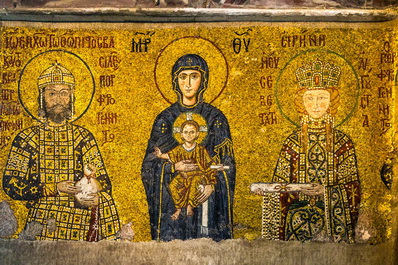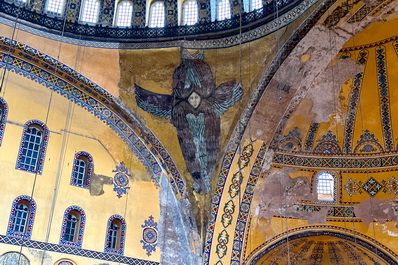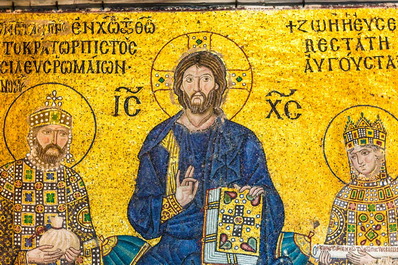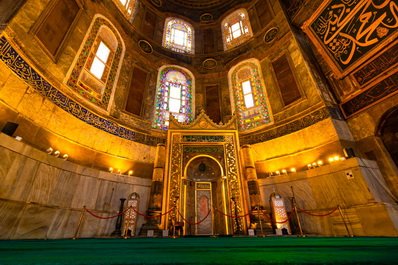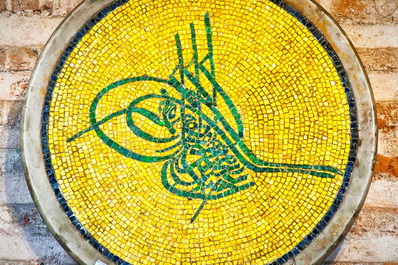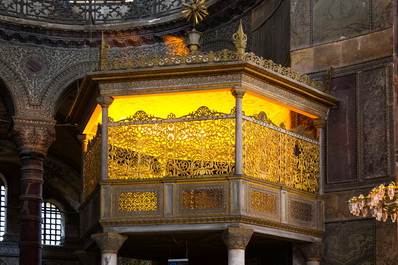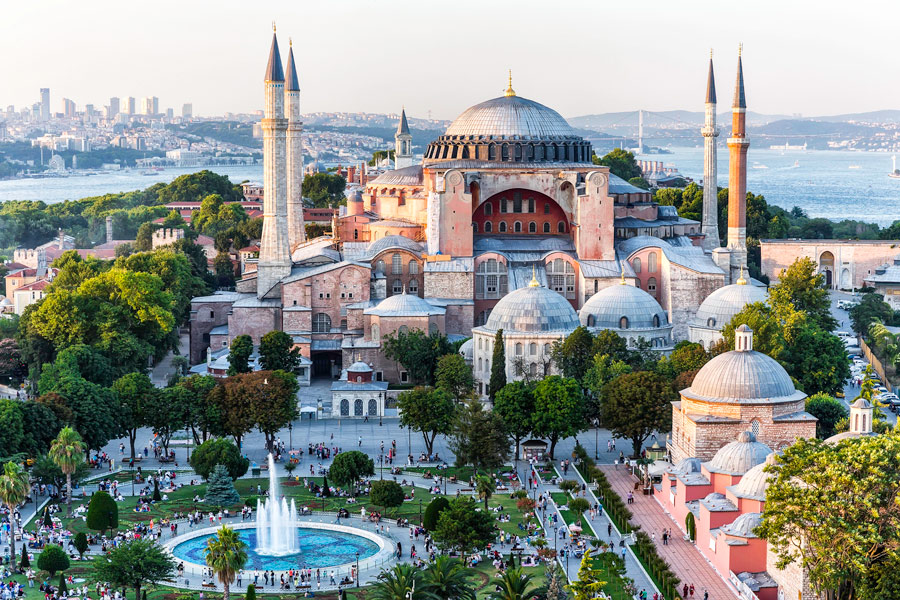
The famous Sultanahmet Square (Sultanahmet Meydanı) in the Fatih district of Istanbul, Turkey (Türkiye), is home to the former church, Hagia Sophia, officially the Hagia Sophia Grand Mosque (Ayasofya-i Kebir Cami-i Şerifi). It is the city’s signature edifice and one of the foremost highlights of any Istanbul travel itinerary, displaying the greatest example of Byzantine architecture. Moreover, today, the monument is one of the world’s astonishing mosques.
Originally built in 537 AD under Emperor Justinian I, the Hagia Sophia Istanbul became a major Ottoman Mosque after the Conquest of Constantinople in the 15th century. This lasting monument, with its soaring dome, glittering mosaics, and marble columns, remained unthrown for fifteen centuries. Recognised as a UNESCO World Heritage Site in 1985, Hagia Sophia embodies Istanbul’s unique fusion of Eastern and Western civilisations. Every year, millions visit the landmark to admire its Byzantine art, study its architectural genius, or merely sense its timeless ambience.
Hagia Sophia Tours
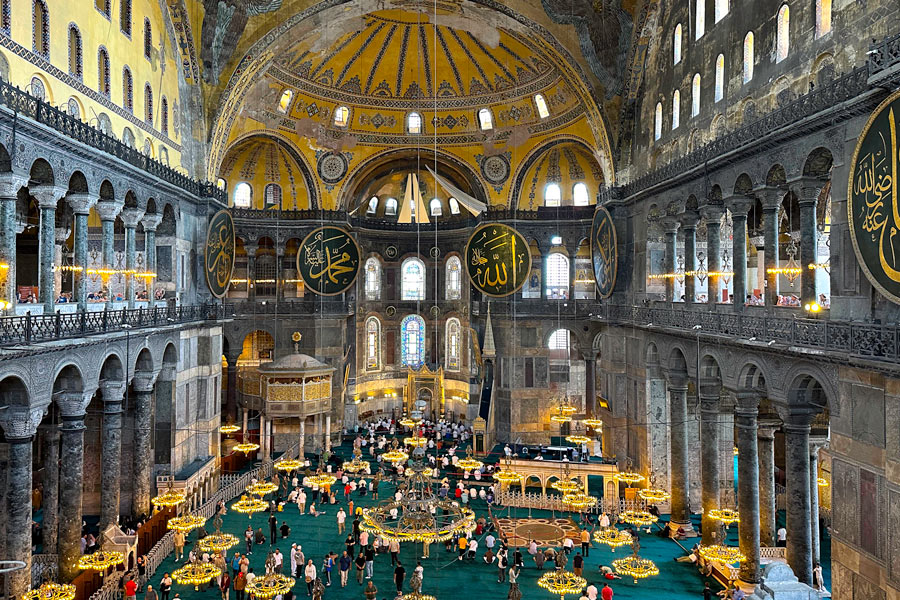
Booking a Hagia Sophia tour is the best way to unlock the monument’s history and architectural marvels. What kind of tours can you book?
Skip-the-line guided tours save you from long queues, especially in peak season.
Many Istanbul travel companies offer combo packages including Ayasofya, Topkapı Palace (Topkapı Sarayı), Blue Mosque (Sultanahmet Camii), and Basilica Cistern (Yerebatan Sarnıcı). It is an ideal choice for first-time visitors.
Travellers seeking a more personalised experience can book private tours based on their interests. On the other hand, independent travellers can take advantage of the audio-guided tours. They need to download the application to their phones before entering the site.
A knowledgeable guide will walk you through the Imperial Gate and narthex, upper galleries, the Omphalion (coronation throne of Byzantine emperors), and Christian mosaics. They will also explain the transition to a mosque and its current role as a functioning place of worship.
History of Hagia Sophia
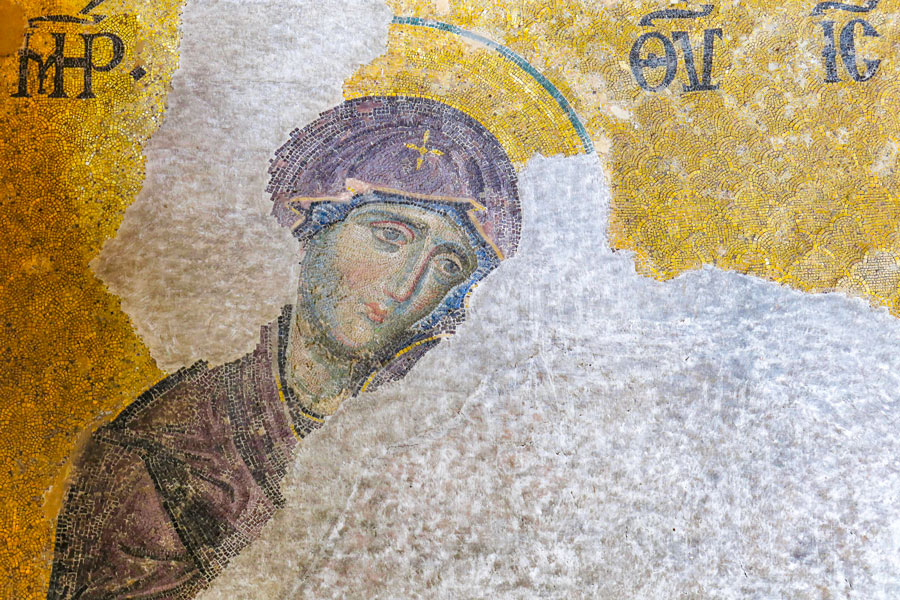
The story of Hagia Sophia, Istanbul, begins in 360 AD, when Emperor Constantine the Great (272-337) founded the first church on this site to serve the capital of the Byzantine Empire. It was ruined in 404 AD following a revolt. The second church existed from 415 AD to 532 AD and suffered the same fate as the first. After two earlier structures were destroyed by fire, Emperor Justinian I (527-565) commissioned a grand new basilica that would surpass the 2nd-century Pantheon in Rome (today the Basilica of St. Mary). Designed by the architects Anthemios of Tralles (today’s Aydin) and Isidor of Miletus, the new Hagia Sophia church rose in just six years. Its massive dome grew into a symbol of divine wisdom and the height of Roman engineering. It stood nearly a millennium as the empire’s main cathedral and a beacon of Orthodox Christianity.
From Imperial Cathedral to Ottoman Mosque
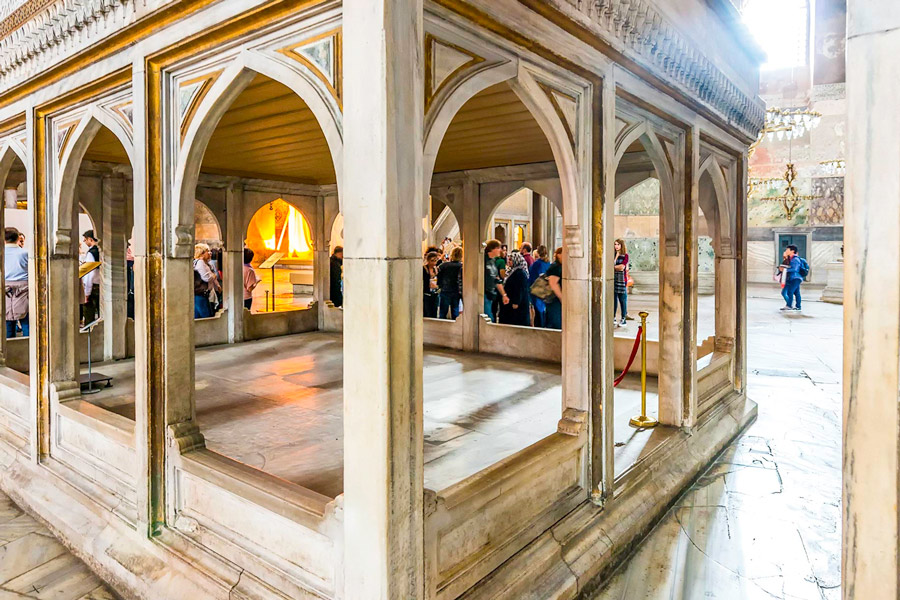
The Hagia Sophia, Istanbul, survived earthquakes, theological debates, and even the Fourth Crusade (1202-1204), when Latin forces turned it briefly into a Roman Catholic church. Its greatest transformation came after the Conquest of Constantinople in 1453, when Sultan Mehmed II ordered its conversion into an Ottoman mosque. Four minarets were erected, Christian icons plastered over yet untouched, and the interior adapted for Islamic worship. Minarets were added over time – two of them by the celebrated Ottoman architect Mimar Sinan (Koca Mi'mâr Sinân Âğâ).
Museum and Modern Mosque
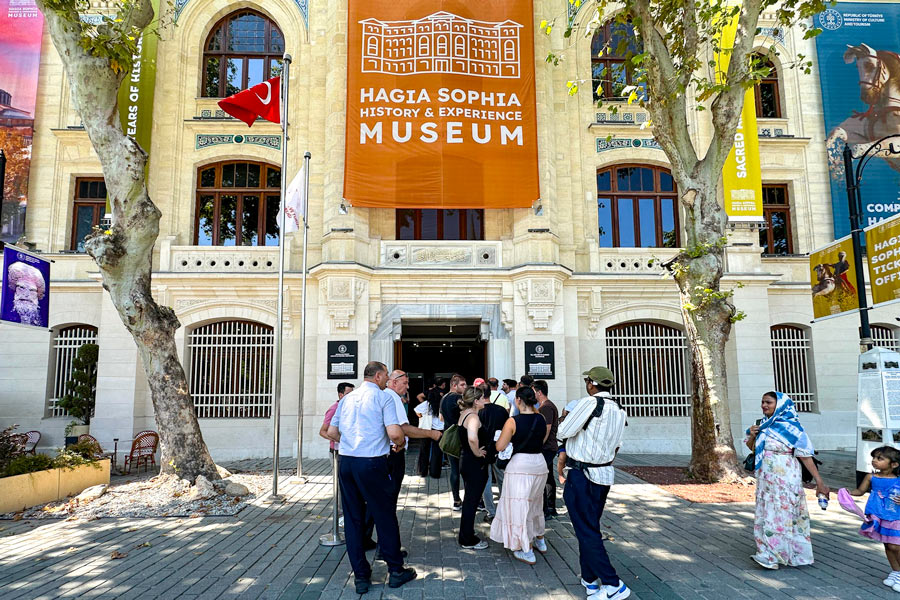
In 1935, the young Turkish Republic turned the Hagia Sophia church into a museum. After being reconsecrated as a mosque in 2020, part of the building was again opened to the public.
Since 2024, the second floor has been the Hagia Sophia History and Experience Museum (Ayasofya Tarih ve Deneyim Müzesi). It features immersive displays, digital projections, artefacts, and multimedia installations. Tourists can view images and mosaics from the Upper Gallery, provided they do not disrupt worship in the main hall.
Hagia Sophia Architecture and Art
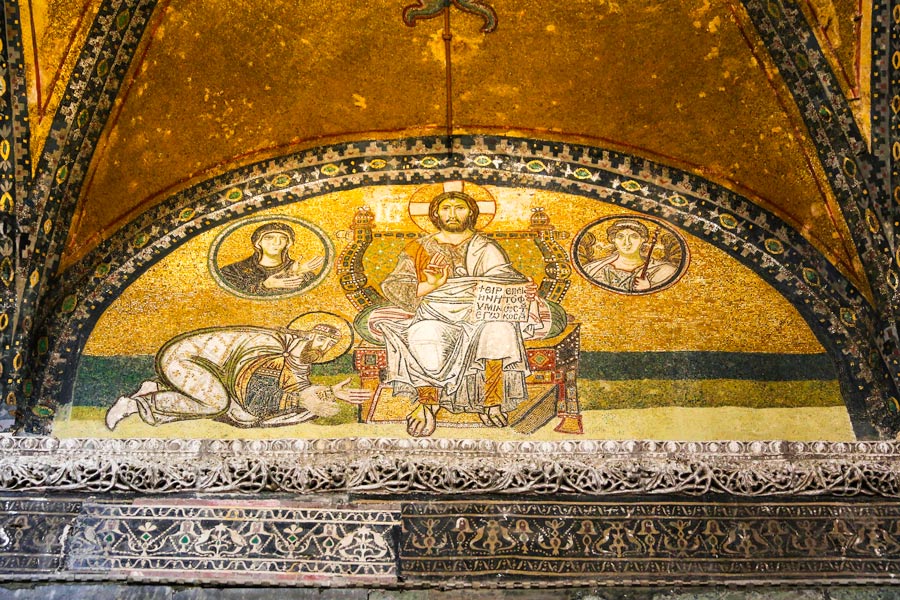
When visitors enter through the 6th-century Imperial Gate or Imperial Door on the ground floor and ascend to the Upper Gallery, which encompasses the North, West, and South sections, they are surrounded by art rich in spirituality and history. The inside of Hagia Sophia reveals Christian mosaics alongside Islamic architecture. For example, the main hall features the 19th-century sultan’s balcony for private prayer (Hünkâr Mahfili). Indeed, discovering the Hagia Sophia art is among the top must-dos in Turkey.
A Dome that Defied Gravity
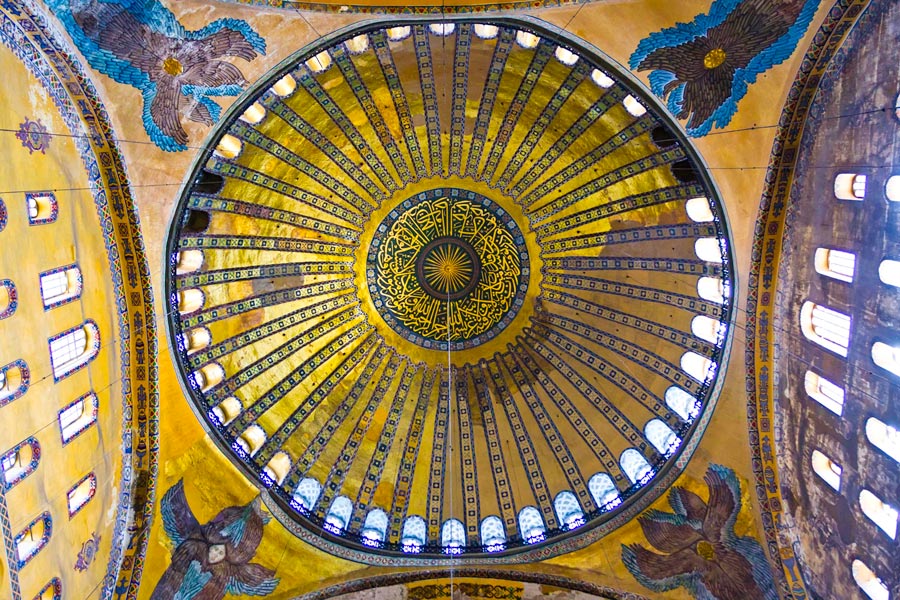
The most fascinating element of the Hagia Sophia church interior is the vast Byzantine dome that appears to hover weightlessly above the marble floor. Spanning 32 metres in diameter and rising 55 metres high, it has amazed travellers for centuries. The secret behind its balance lies in the question many still ask: “Which architectural component supports the dome of Hagia Sophia?” The answer is the system of pendentives, four-triangle curved supports that distribute the dome’s circular weight onto square pillars below. One can easily recognise them because each one is decorated with a seraph. This innovation, introduced during the construction of Hagia Sophia, Istanbul, during the reign of Emperor Justinian I, revolutionised architecture and emerged as a defining hallmark of Byzantine architecture.
Mosaics, Calligraphy, and Marble Splendour
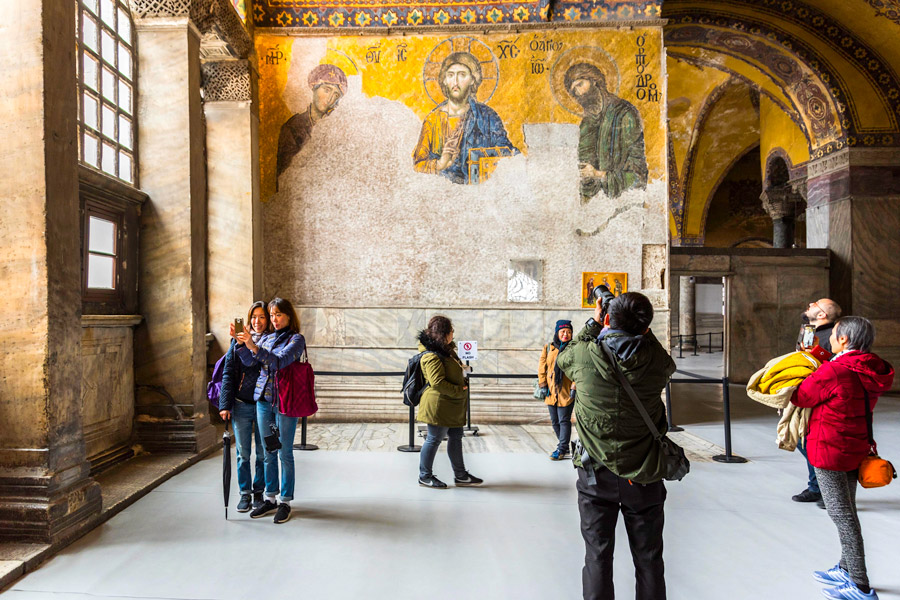
Exploring the Hagia Sophia inside, take time to appreciate its mosaics. The most praised is the 13th-century mosaic of Jesus Christ flanked by John the Baptist and Virgin Mary in the South Upper Gallery, known as the Christ Pantocrator and Deesis mosaic. In ancient Greek, Χριστὸς Παντοκράτωρ means “Christ the Almighty”. Other remarkable Byzantine mosaic artworks are in the South Vestibule. They include the 10th-century mosaic of Virgin and Child and an image on each side. These medallion images depict Emperors Constantine the Great and Justinian presenting the city and church to the Virgin. Each icon in Ayasofya, composed of thousands of golden tesserae, radiates a sacred brilliance. And the surrounding medallions on the ground floor enhance that grandeur through the calligraphy of Allah, the Prophet, his two grandchildren, and the first four caliphs.
Today, the Hagia Sophia church interior is one of the world’s most extraordinary spaces, where every surface is a story of ageless elegance.
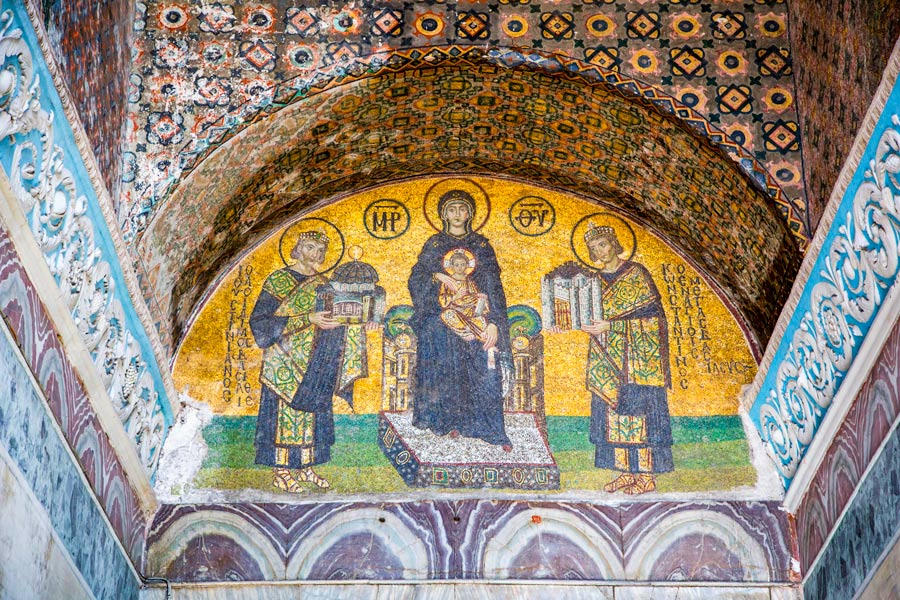
Mimar Sinan’s Reinforcements and the Living Monument
In the 16th century, Mimar Sinan, the genius of Ottoman architecture, reinforced the delicate Byzantine dome with four exterior buttresses to the west. The first ones were added in the 14th century, on the east and north sides. This careful restoration helped preserve the basilica's original harmony while enhancing its stability.
Hagia Sophia Significance: Religion and Culture
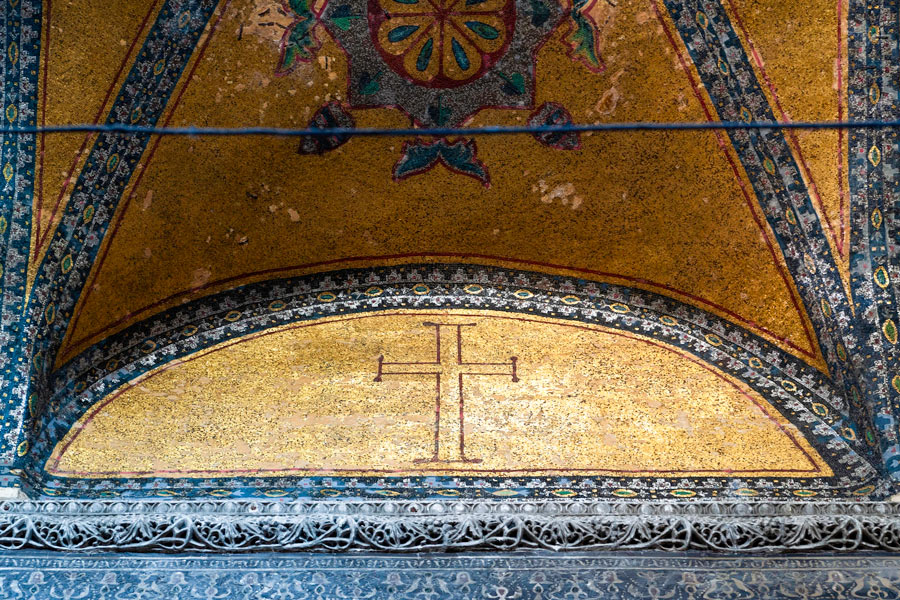
The meaning of Hagia Sophia in Greek is “Holy Wisdom,” a name denoting not a saint but the divine Logos – the eternal Word of God. This concept expresses the monument’s soul, making it a symbol of faith and power for Christianity and Islam. For nearly a millennium, the Hagia Sophia, Istanbul, was the grand cathedral of the Byzantine Empire, where emperors were crowned beneath its enormous dome. After the Fall of Constantinople, it was modified into an imperial mosque, continuing to express devotion, grandeur, and authority – this time within the Ottoman world.
Few edifices in human history illustrate spiritual coexistence as vividly as Ayasofya. Above the Imperial Door, a 10th-century mosaic portrays Jesus on the throne, holding a Bible inscribed in Greek: “Peace be with you, I am the light of the world”. High above, on the dome, an Islamic calligraphic inscription echoes the same idea in another tongue: “Light upon light. Allah guides to His light whom He wills”. (Sura an-Nur [24:35]). This profound juxtaposition of the Hagia Sophia art unites two faiths in a shared vision of divine illumination.
Hagia Sophia icons hold profound significance for followers of Eastern Orthodox and Catholic churches. These holy paintings of Christ, the Virgin Mary, and the saints were not merely art but a medium of prayer and contemplation.
Recognised today as a UNESCO World Heritage Site, the Hagia Sophia Church-Mosque illustrates the dialogue between East and West, past and present. To the Western world, it stands as the pinnacle of Byzantine art and a living testament to cultural resilience. It proves that sacred spaces can evolve while preserving the universal essence of faith and wisdom.
Visiting Ayasofya Camii Today
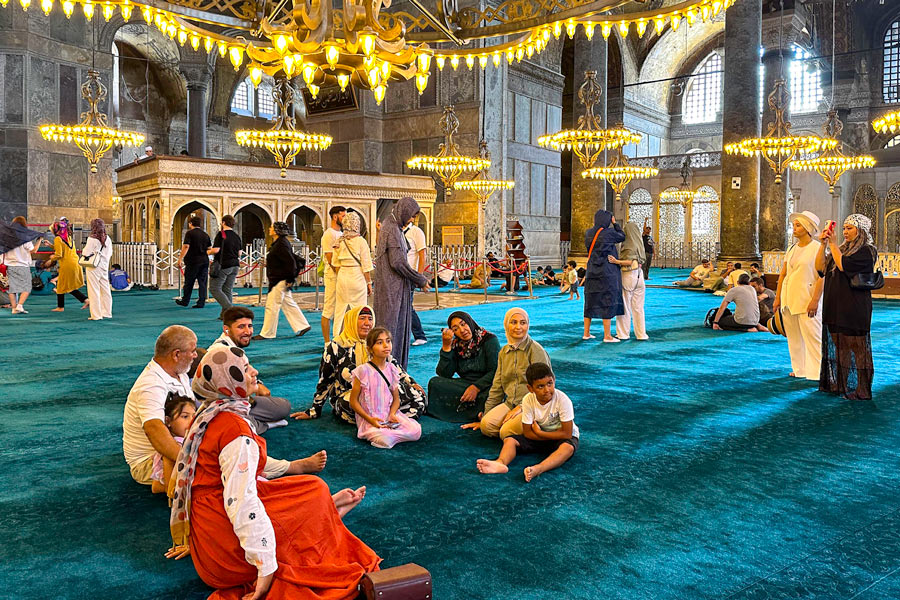
Visiting Hagia Sophia today is an essential highlight for anyone planning a Turkey travel experience. The fifteen centuries of history and architecture unfold on this site, making it one of the most visited landmarks in Istanbul.
Hagia Sophia Tickets and Opening Hours
Hagia Sophia tickets can be purchased at a ticket booth at the South Gate. Visitors pay €25 (as of 2025) to enter the upper galleries and view the structure’s interior from above. Access to the adjacent Hagia Sophia Museum requires another ticket of €25, bringing the total cost for a complete visit to roughly €50.
Foreign Muslim visitors who want to pray enter through the main door without paying the Hagia Sophia entrance fee. The site is usually open from 9:00am to 7:00pm, though it closes to tourists during daily and Friday prayers.
Can non-Muslims visit Hagia Sophia?
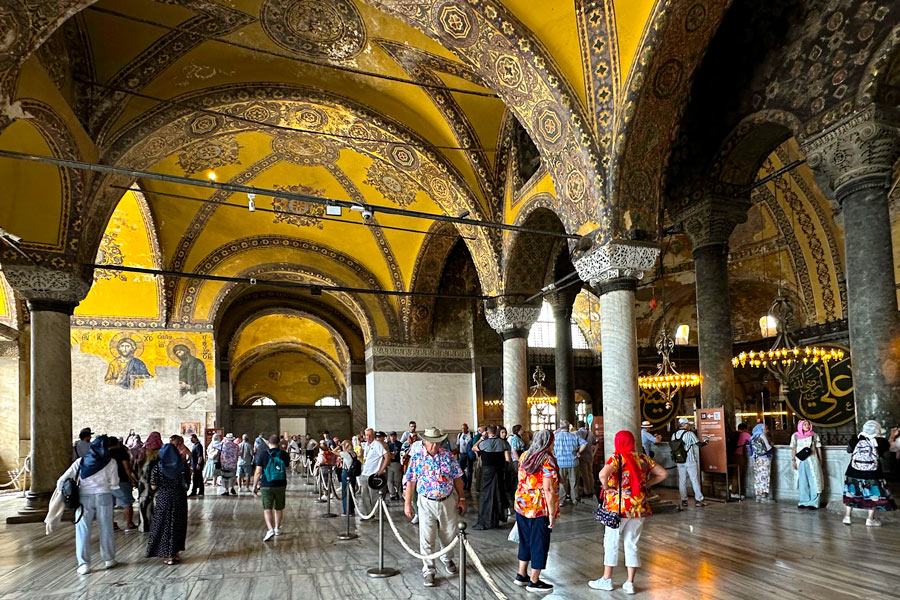
Non-Muslim tourists are not allowed to enter the carpeted main prayer hall. Instead, they may visit the monument via the south entrance, beside the Sultan Ahment III Fountain near Topkapi Palace. Since reconversion into a mosque, the Hagia Sophia, Istanbul, welcomes worshippers and visitors under distinct arrangements.
Dress Code and Etiquette
Because the Hagia Sophia church functions as a place of worship, a modest dress code is required for everyone entering the building. Women should wear a headscarf, and both men and women must cover their shoulders and knees. Footwear is removed before walking on the carpets in the main hall, and visitors should be quiet when prayers are in progress. Can non-Muslims visit Hagia Sophia? Yes, through the designated tourist entrance on the south side. Photography is allowed but without flash to protect the fragile mosaics and frescoes.
Best Time to Visit & Nearby Attractions
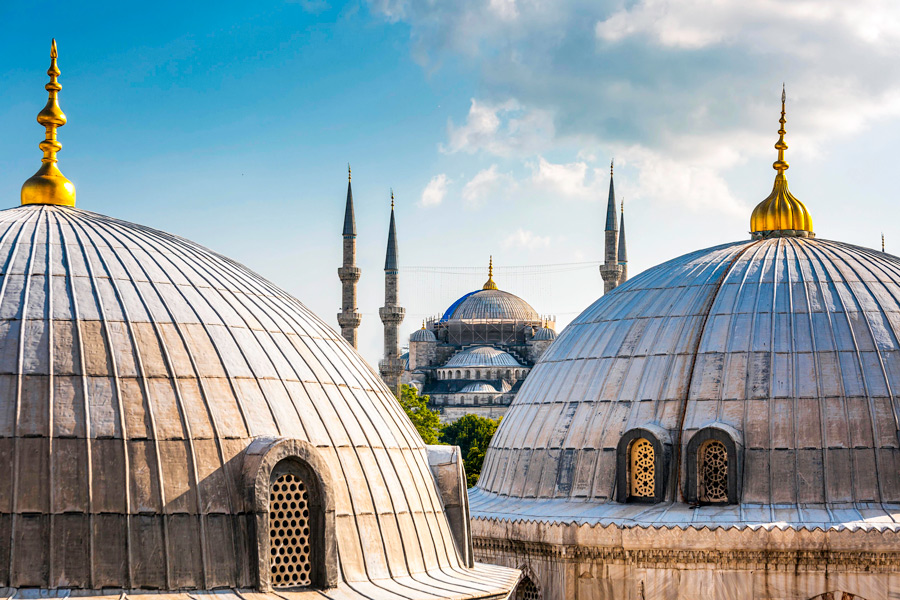
The best time to visit Hagia Sophia Grand Mosque is early morning or late afternoon. The sunlight fills the upper aisles at that time, and the queues are thinner. The mosque is within a few minutes’ walk of the Blue Mosque, Topkapi Palace, Basilica Cistern, and Istanbul Archaeology Museum. Visitors will find diverse restaurants near Hagia Sophia, including traditional Turkish cafes and rooftop Istanbul restaurants overlooking the Bosphorus. Accommodation is plentiful: the best hotels near Hagia Sophia range from luxury properties with domed-roof views to quaint Ottoman-style guesthouses, many ranked among the top hotels in Sultanahmet for location and atmosphere.
Fan Facts About Hagia Sophia
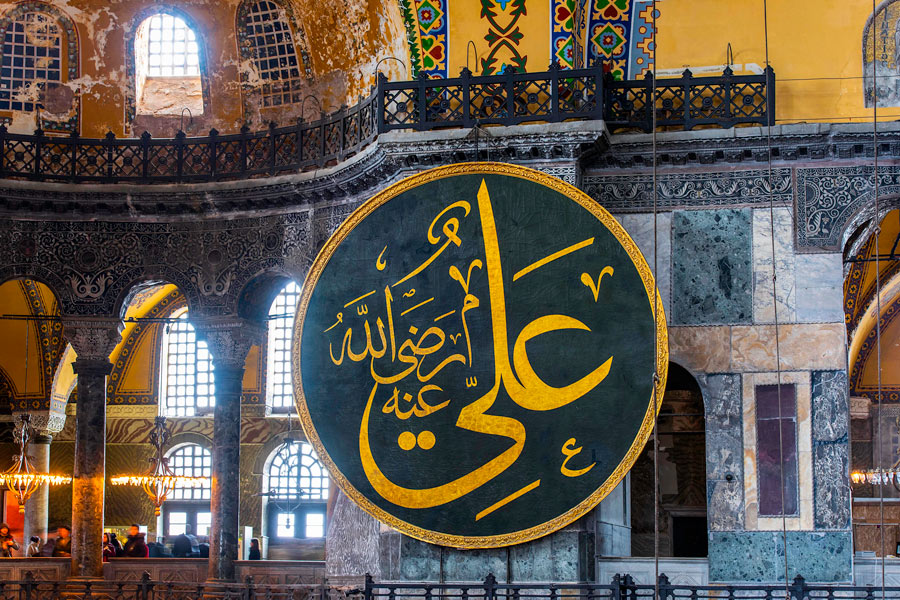
Few monuments rival Hagia Sophia, Istanbul, in beauty and endurance. Built in a seismic zone, this marvel of Byzantine architecture has survived earthquakes without completely collapsing. What is its secret?
- Earthquake resilience: The St. Sophia Church was reinforced by engineers over the centuries. The buttresses appeared in the 14th century, with additional supports added in the 16th century under Mimar Sinan.
- Material & masonry: Researchers note brick units approximately 50 x 30 x 4-5 cm. Mortar joints are equal in thickness to the bricks. The binder mixes brick and stone powder; analysis indicates a volcanic pozzolana component. Its elasticity lets the walls deform without cracking, absorbing tremors. Micro-cracks could self-seal over time.
- Light & marble: Justinian sourced premium materials empire-wide. Floors use Marmara Island marble, prized for light reflection (the Marble Door is made of the same stone). The walls on the ground floor are veneered with white, green, and pink marble; green marble from Greece, black stone from the Bosphorus, and gems from Syria are recorded.
- Byzantine mosaics: About 90% of glass mosaics were imported from Egypt. The upper galleries were clad with gold-leaf mosaics; by the 6th century, 16,000 m² were covered. In the 15th century, the Ottomans plastered many surfaces.
- Construction phases: The present basilica is the third on this site. Elements of the 5th-century predecessor can be found in the courtyard (carved friezes and portico).
- Minarets: Ordered by Mehmed II after 1453; the red brick minaret is the earliest, with three more added later. A thinner of four was commissioned by Bayezid II (1481-1512), the successor of Sultan Mehmed II. The two minarets to the west were erected by Selim II (1566-1574) under Mimar Sinan.
- Hidden layers: Some scholars suggest an early image of Christ may lie beneath the dome’s Islamic calligraphy. The Hagia Sophia Committee members have also reported a hypogeum/tomb and vaulted structures under the Hagia Sophia Mosque.
- Hungarian candlesticks: Sultan Suleiman the Magnificent brought two large candlesticks from the Kingdom of Hungary and placed them on each mihrab side.
- Related site: Little Hagia Sophia (Küçük Ayasofya Camii), near the Sea of Marmara and the ruins of the Great Palace of Constantinople, was built by Justinian in 536.
- Visitors note: The Hagia Sophia History and Experience Museum has a café and a gift shop on the lower floor.
Hagia Sophia Istanbul Pictures
For those who wish to see Hagia Sophia’s splendour in detail, our gallery of Hagia Sophia images offers a closer look at the Christian mosaics and Islamic architecture.


